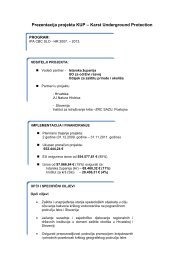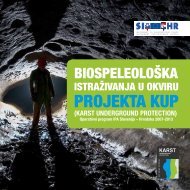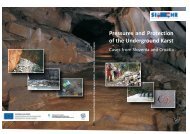Case Studies from the Dinaric Karst of Slovenia
Case Studies from the Dinaric Karst of Slovenia
Case Studies from the Dinaric Karst of Slovenia
You also want an ePaper? Increase the reach of your titles
YUMPU automatically turns print PDFs into web optimized ePapers that Google loves.
films flowing down inclined surfaces and <strong>the</strong>dissolution kinetics <strong>of</strong> <strong>the</strong> CO 2-containing rainwater(Dreybrodt & Kaufmann 2007). Some <strong>of</strong><strong>the</strong>se features and widely spread so <strong>the</strong>y gotspecial names.According to Ford and Williams (2007) <strong>the</strong>main groups are circular plane forms like micropits,pits, pans, heelprints. Linear formsthat are fracture-controlled are micr<strong>of</strong>isures,splitkarren and grikes. Linear forms that arehydrodynamically controlled are microrills, solutionchanels or rillenkarren, solution runnels,decantation runnels and flutings.Polygenetic formsare mixtures <strong>of</strong> solutionchannels or assamblages <strong>of</strong> karren: karenfeld,limestone pavement (clints and grikes),stepped pavements, pinnacle karst, corridorkarst, costal karren.Common features on <strong>the</strong> bare horizontalrock surfaces exposed to rain are solutionpans. This is circular or irregular depression in<strong>the</strong> surface <strong>of</strong> <strong>the</strong> rock with flat bottom and<strong>of</strong>ten undercut edges. They are <strong>from</strong> few cmto 1 m large. Corrosion in <strong>the</strong>m is encouragedby biologic processes like decay <strong>of</strong> organicmatter where organic acids form. Water <strong>from</strong><strong>the</strong>m evaporates; crystals <strong>of</strong> calcite are blownby wind or washed out by rain. Shepards <strong>of</strong>tenused for watering <strong>the</strong> animals (Perica 2009).Characteristic form <strong>of</strong> corrosion is rillenkarren.They are formed by channelled flow <strong>of</strong><strong>the</strong> rain water on steep slopes on <strong>the</strong> tops <strong>of</strong>limestone blocks. They are few cm wide anddeep, semi-circulars in cross section and havesharp edges <strong>of</strong> crests between <strong>the</strong>m. On <strong>the</strong>lower side <strong>the</strong>y <strong>of</strong>ten transform into plat, nondissected surface.Down <strong>the</strong> slope <strong>of</strong> <strong>the</strong> exposed rock largerchannels, runnels form. They are few tens <strong>of</strong>centimeters wide and can be several metersFig. 22: Kamenitza on Velebit mountain (photo: N. Zupan Hajna).31










